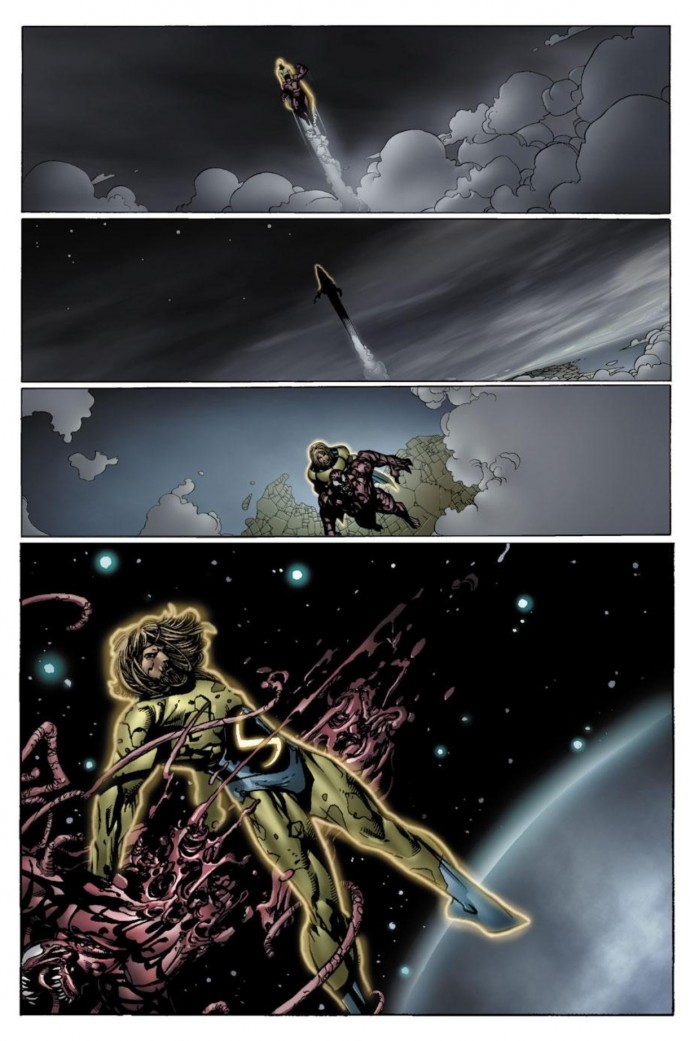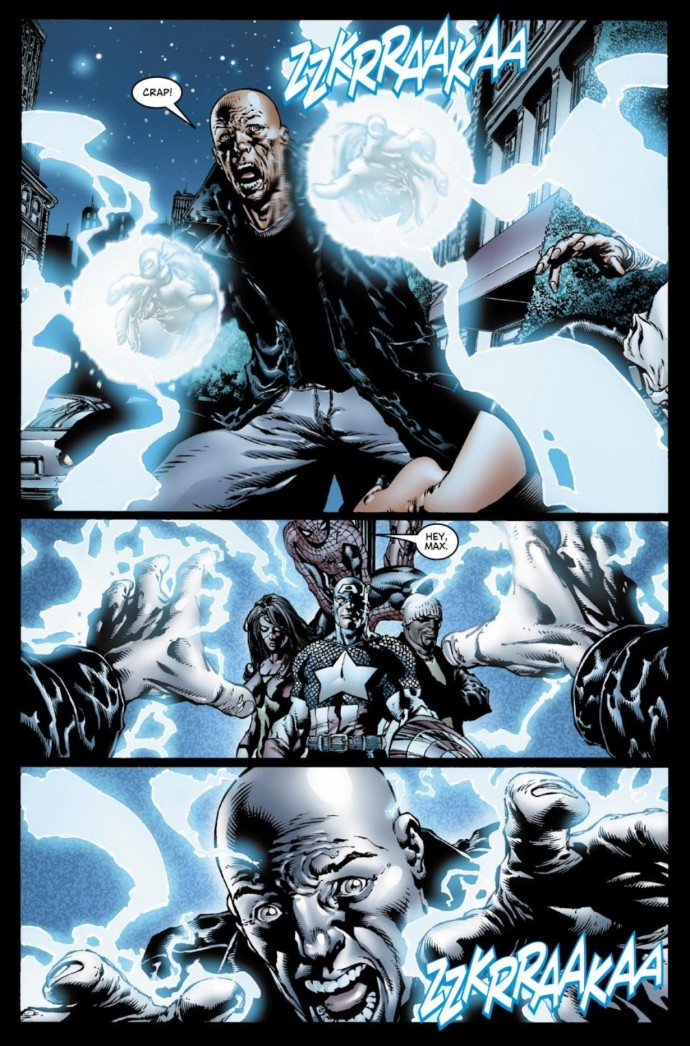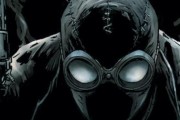As part of Chasing Amazing’s X-Men/Avengers 50th anniversary celebration in September, the site is reposting older posts that relate to these great franchises. This post is originally from July 1, 2013.
With the Raft supervillain prison being such a focal point in the current Superior Spider-Man arc, I thought the timing was appropriate to discuss another one of my Spider-Man blind sports: 2005’s New Avengers #1-6 “Breakout” storyline, which marked the Raft’s first appearance and origin (sorta).
While some of my previous “blind spot” features were inexcusable omissions from my Spider-Man knowledge base, I can at least attempt to justify why “Breakout” was off my radar for so long. After giving up on new Spider-Man comics for years because of my frustration and angst with the “Clone Saga” storyline, my adoration for Sam Raimi’s Spider-Man 2 in 2004 was the final step in convincing me it was time to give one of my childhood loves a second chance. There were other factors involved in getting me back into collecting, including the highly coveted “big box of comics” I often write about around here, but maybe an hour had passed when I walked out of that movie theater in July and went to my local comic book shop to pick up some comics from J. Michael Straczynski’s run on Amazing Spider-Man. From there, I subscribed to ASM so I would never miss another issue again.
But as was the case with the Marvel Knights: Spider-Man series, I was still just dipping my toe in the water and didn’t want to get in too deep with too many different comic book series to follow. The fact that New Avengers wasn’t even a dedicated Spider-Man title made me even more resistant to picking it up, despite the fact that I was beyond confused when Spider-Man started hanging out at Avengers Mansion during certain significant ASM arcs like “The Other” and “Mr. Parker Goes to Washington.”
And of course, I can’t waste an opportunity to once again get on my soap box to voice my general opposition to Spider-Man being on super-teams. Despite the fact that he was the star of his very own “team-up” series in the 1970s and early 80s, Spider-Man has always felt like a lone wolf, and even he willingly owns up to the fact when Captain America first asks him to be on the “new” Avengers in this arc (“People hate me.”). I would be willing to overlook this disrespect to continuity if Spider-Man’s place on these teams was well executed by the writers. Guys like Brian Michael Bendis and Jonathan Hickman – two great writers – have seemingly failed, in my opinion, to work Spidey into a super-team. Unfortunately, when Spider-Man is not the central character of the series, the writer struggles to find Spidey’s voice and often resorts to portraying him as a one-dimensional jokester.
Shockingly enough, “Breakout” seems to nail how to integrate Spider-Man on a super-team in a way where the character’s unique attributes are still apparent – at least through the arc’s first four issues. And there’s the rub that has seemingly doomed the Spidey/super-team concept for as long as I can remember: these Avengers stories, especially with Bendis at the helm, tend to get so big and broad that it’s only a matter of time before a street-level character like Spider-Man gets eclipsed by the plot’s grandiosity.
For Spider-Man fans, “Breakout” certainly starts in very familiar/comfortable territory. Long-time Spider-Man villain and Sinister Six co-founding member Electro is revealed to be one of the primary antagonists for what’s about to go down (though a shadowy mystery figure is giving him his instructions). Electro even gets to deliver a fantastic line about “costume or no costume” before David Finch and Danny Miki give us a gorgeous splash page of fully-costumed Electro smiling deviously at the reader. As of this moment, the story feels like it’s going to be a great Spider-Man comic.
Immediately following the Electro scene, the Raft is introduced, along with its first visitors, Matt Murdock/Daredevil, Foggy Nelson and Luke Cage. The scene then shifts right back to the world of Spider-Man when we see Peter and Mary Jane Parker’s New York City apartment where the two are arguing over watching a Huge Grant movie. There’s a certain silliness to the sequence, but it’s done to contrast the imminent tension and danger unfolding at the supervillain prison right across the water, and doesn’t feel forced or out of place in the bigger picture of the story Bendis is telling. When Peter notices something is going on out on the water (the first of a comically high number of jailbreaks in the Raft’s history), MJ gives her blessing and he’s back on superhero duty.
Here Bendis perfectly captures the Parker luck – he has no way to swing out to the prison and when the helicopter he’s clinging to goes down, he ends up having to swim in the freezing water. Once he arrives at the Raft, Spidey gets to have a great exchange with Captain America, who ends up calling the Web Slinger a “smartass.”
So far, so good, right Webheads? When the gallery of the Raft’s imprisoned rogues is introduced, there’s a large cross-section of guys associated with different heroes. But one of the guys who gets a scene of prominence is Carnage. The serial-killing symbiote starts off trying to sneak up on poor Foggy before he gets identified as one of Spider-Man’s guys, which was a nice little touch from Bendis. Then, we get a scene that becomes a major part of Carnage’s back-story: he’s carted off into space by the mysterious hero Sentry and ripped into half (and presumably killed).
He’s not seen again for nearly five years (which is an eternity in comic book time) in Zeb Wells’ Carnage mini-series. After reading “Breakout” I’m glad that I finally got to witness the origin of this break (it’s probably part of the reason so many people were willing to praise Wells’ recent Carnage work since after saturating the printed world with the symbiote for years, the two mini’s that came out over the past two years really marked a significant return from exile for good ol’ Cletus Kasady).
Once the New Avengers are formed, the group of heroes seemingly has a decision in front of them – and this is where Bendis and the team-concept starts to lose me. They’re able to dispatch Electro pretty quickly, which I think cheapens his otherwise awesome introduction (though we do have a great scene where Bendis captures Peter’s guilt perfectly as he bemoans the fact that one of “his” guys started this whole mess), not to mention the scene indirectly makes Spider-Man look like a chump for occasionally having a hard time with Max Dillon.
So what’s next for the New Avengers? Common sense says they go after the 40+ supervillains running around in New York City and get them back into captivity. But instead, the story becomes about a larger investigation about “who” is actually behind everything.
The further away the story gets away from the streets of NYC, the more Spidey fades into the background, only to get pulled out for the occasional one-liner or embarrassing sequence. Whereas I found the Peter/MJ stuff in the beginning to be in the spirit of traditional Spider-Man comics, Bendis’ characterization comes across more juvenile the deeper we go (really, Spider-Man is going around NYC free-balling now?).
By the time “Breakout” wraps, were dealing with conspiracy theories involving S.H.I.E.L.D., the government and everyone in-between. I liked it much better when the Avengers were fighting Electro and Purple Man, but I guess if they stuck to such low level confrontations, it wouldn’t be a comic book about “Earth’s Mightiest Heroes.”
I probably need to dive further into New Avengers to see where things ultimately go with Spider-Man (and thanks to the Marvel U app on my iPad, this will be very easy to do). But if the more recent wave of Avengers stories are any indication of things, I’m probably going to be disappointed. Obviously during the Civil War-era, Peter and Spider-Man were focused on a ton in large part because of how his unmasking at the urging of Tony Stark ended up being one of THE major catalysts in that mini-series. In the meantime, I have the first two-thirds of “Breakout” to look back on as evidence that every once in a while, Spidey can be done right on a super-team.
All images from New Avengers (vol. 1) #1-6: Brian Michael Bendis, David Finch & Danny Miki













I don’t remember Spider-Man’s role in New Avengers getting any better or any bigger on the whole after “Breakout,” although he got his moment to shine every once in a while. Still, I quite enjoyed New Avengers at the time — its cast made it really unlike any Avengers comic that had come before it, and as someone who didn’t care much for the “traditional” Avengers then, that was a great thing. It’s too bad that the inclusion of Spider-Man and Wolverine never quite evolved into more than a reason to get people like me to buy the book. 😛
You might also want to check out the miniseries “Spider-Man: Breakout,” which is about Spidey rounding up the criminals who escaped from the Raft (a plot point Bendis seemingly forgot about). I remember enjoying that and wishing that Bendis would have injected the main New Avengers comic with a similar, stronger characterization of Spider-Man.
In the meantime, I have the first two-thirds of “Breakout” to look back on as evidence that every once in a while, Spidey can be done right on a super-team.
And now, thanks to you, so do we.
Breakout got me into reading Marvel comics as an adult and through it I started collecting ASM in trades from Coming Home (and nearly every other series from Disassembled onwards). The inclusion of Spider-Man and Wolverine in the Avengers line up was what caught my attention, compared to characters like Jack of Hearts or The Vision, (who at the time I had no knowledge of or care for) the line up was more dynamic and dare I say edgy lol.
Bendis’ Logan/Pete banter is probably one of my favourite things in comics. There’s a page in thr New Avengers arc of ASM where spidey pushes wolverine through a window at Avengers tower. Still cracks me up every time I think about it